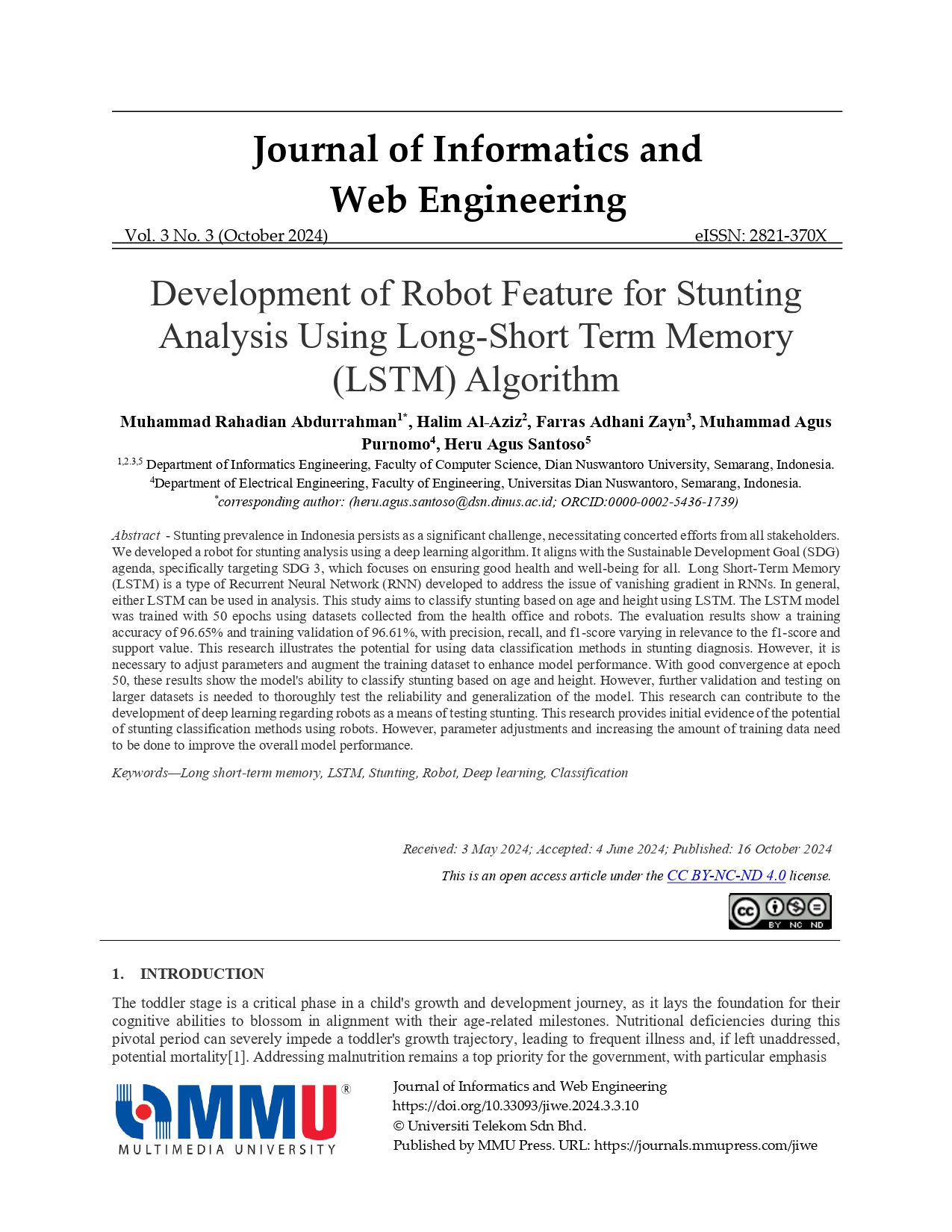Development of Robot Feature for Stunting Analysis Using Long-Short Term Memory (LSTM) Algorithm
Main Article Content
Abstract
Stunting prevalence in Indonesia persists as a significant challenge necessitating concerted efforts from all stakeholders. We developed robot for stunting analysis using deep learning algorithm. It aligns with the Sustainable Development Goal (SDG) agenda, specifically targeting SDG 3, which focuses on ensuring good health and well-being for all. Long Short-Term Memory (LSTM) is a type of Recurrent Neural Network (RNN) designed to overcome the vanishing gradient problem in traditional RNNs. In general, either LSTM can be used in analysis. This study aims to classify stunting based on age and height using LSTM. The LSTM model was trained with 50 epochs using datasets collected from the health office and robots. The evaluation results show training accuracy of 96.65% and training validation of 96.61%, with precision, recall and f1-score varying with relevance to the f1-score and support value. This research illustrates the potential for using data classification methods in stunting diagnosis. However, it is necessary to adjust parameters and increase the amount of training data to improve model performance. With good convergence at epoch 50, these results show the model's ability to classify stunting based on age and height. However, further validation and testing on larger datasets is needed to thoroughly test the reliability and generalization of the model. This research can contribute to the development of deep learning regarding robots as a means of testing stunting. This research provides initial evidence of the potential of stunting classification methods using robots. However, parameter adjustments and increasing the amount of training data need to be done to improve the overall model performance.
Article Details

This work is licensed under a Creative Commons Attribution-NonCommercial-NoDerivatives 4.0 International License.
All articles published in JIWE are licensed under a Creative Commons Attribution-NonCommercial-NoDerivatives 4.0 International (CC BY-NC-ND 4.0) License. Readers are allowed to
- Share — copy and redistribute the material in any medium or format under the following conditions:
- Attribution — You must give appropriate credit, provide a link to the license, and indicate if changes were made. You may do so in any reasonable manner, but not in any way that suggests the licensor endorses you or your use;
- NonCommercial — You may not use the material for commercial purposes;
- NoDerivatives — If you remix, transform, or build upon the material, you may not distribute the modified material.
References
S. Abdillah, “The Effect of Maternal and Child Factors on Stunting in Children Under Five Years in Rural Indonesia,” Kne Life Sciences, vol. 7, no. 2, pp. 813–822, 2022. doi: 10.18502/kls.v7i2.10382.
J. Indra and K. Khoirunurrofik, “Understanding the role of village fund and administrative capacity in stunting reduction: Empirical evidence from Indonesia,” PLOS ONE, vol. 17, no. 1, e0262743, 2022. doi: 10.1371/journal.pone.0262743.
A. Soliman, V. De Sanctis, N. Alaaraj, S. Ahmed, F. Alyafei, N. Hamed, N. Soliman “Early and Long-term Consequences of Nutritional Stunting: From Childhood to Adulthood,” Acta Biomed, vol. 92, no. 1, e2021168, 2021. doi: 10.23750/abm.v92i1.11346.
H. BKPK, “Buku Saku Hasil Studi Status Gizi Indonesia (SSGI) Tahun 2021,” Badan Kebijakan Pembangunan Kesehatan | BKPK Kemenkes. 2024. https://www.badankebijakan.kemkes.go.id/buku-saku-hasil-studi-status-gizi-indonesia-ssgi-tahun-2021/
Kemenkes, “Kementerian Kesehatan Rilis Hasil Survei Status Gizi Indonesia (SSGI) Tahun 2022,” Kemenkes Unit Pelayanan Kesehatan. 2024. https://upk.kemkes.go.id/new/kementerian-kesehatan-rilis-hasil-survei-status-gizi-indonesia-ssgi-tahun-2022
B. D. Welasasih, “Beberapa Faktor yang Berhubungan dengan Status Gizi Balita Stunting”, The Indonesian Journal of Public Health, vol. 8, no. 3, pp. 99–104. 2012.
S. Vollmer, C. Bommer, A. Krishna, K. Harttgen, and .S. Subramanian, “The association of parental education with childhood undernutrition in low- and middle-income countries: comparing the role of paternal and maternal education,” International Journal of Epidemiology, vol. 46, no. 1, pp. 312–323, 2017, doi: 10.1093/ije/dyw133.
U. Umiatin, W. Indrasari, T. Taryudi, and A. F. Dendi, “Development of a Multisensor-Based Non-Contact Anthropometric System for Early Stunting Detection,” Journal of Sensor and Actuator Networks, vol. 11, no. 4, 2022. doi: 10.3390/jsan11040069.
A. Gubawa, T. Abuzairi, and A. Henri, “Electronic system design for clinical applications of stunting case,” AIP Conference Proceedings, vol. 2344, no. 1, 050004, 2021. doi: 10.1063/5.0047173.
S. Ndagijimana, I. Kabano, E. Masabo, and J.M. Ntaganda, Predicting stunting in Rwanda using artificial neural networks: a demographic health survey 2020 analysis, F1000Research, vol. 13, 128,2024. doi: 10.12688/f1000research.141458.1
O.N. Chilyabanyama, R. Chilengi, M. Simuyandi, C.C. Chisenga, M. Chirwa, K. Hamusonde, R.K. Saroj, N.T. Iqbal, I. Ngaruye, and S. Bosomprah, “Performance of Machine Learning Classifiers in Classifying Stunting among Under-Five Children in Zambia,” Children, vol. 9, no. 7, 1082, 2022. doi: 10.3390/children9071082.
D. J. Raiten and A. A. Bremer, “Exploring the Nutritional Ecology of Stunting: New Approaches to an Old Problem,” Nutrients, vol. 12, no. 2, 371, 2020. doi: 10.3390/nu12020371.
D. Niu, Z. Xia, Y. Liu, T. Cai, T. Liu, and Y. Zhan, "ALSTM: Adaptive LSTM for durative sequential data," IEEE 30th IEEE International Conference on Tools with Artificial Intelligence (ICTAI), pp. 151-157, 2018. doi: 10.1109/ICTAI.2018.00032.
S.M. Al-Selwi, M.F. Hassan, S.J. Abdulkadir, A. Muneer, E.H. Sumiea, A. Alqushaibi, M.G. Ragab, “RNN-LSTM: From applications to modeling techniques and beyond—Systematic review,” Journal of King Saud University - Computer and Information Sciences, vol. 36, no. 5, 102068, 2024. doi: 10.1016/j.jksuci.2024.102068.
A. Sherstinsky, “Fundamentals of Recurrent Neural Network (RNN) and Long Short-Term Memory (LSTM) network,” Physica D: Nonlinear Phenomena, vol. 404, 132306, 2020. doi: 10.1016/j.physd.2019.132306.
S. Zargar, "Introduction to Sequence Learning Models: RNN, LSTM, GRU," Department of Mechanical and Aerospace Engineering, North Carolina State University, 2021. doi: 10.13140/RG.2.2.36370.99522.
J.M. Helm, A.M. Swiergosz, H.S. Haeberle, J.M. Karnuta, J.L. Schaffer, V.E. Krebs, A.I. Spitzer, and P.N. Ramkumar, “Machine Learning and Artificial Intelligence: Definitions, Applications, and Future Directions,” Current Reviews in Musculoskeletal Medicine, vol. 13, no. 1, pp. 69–76, 2020. doi: 10.1007/s12178-020-09600-8.

